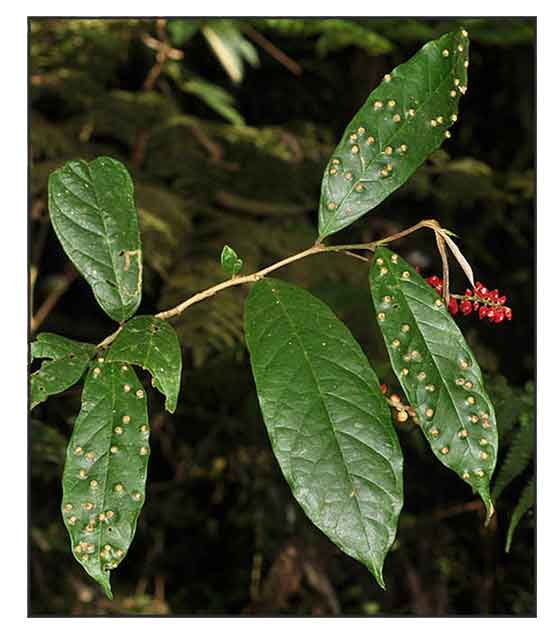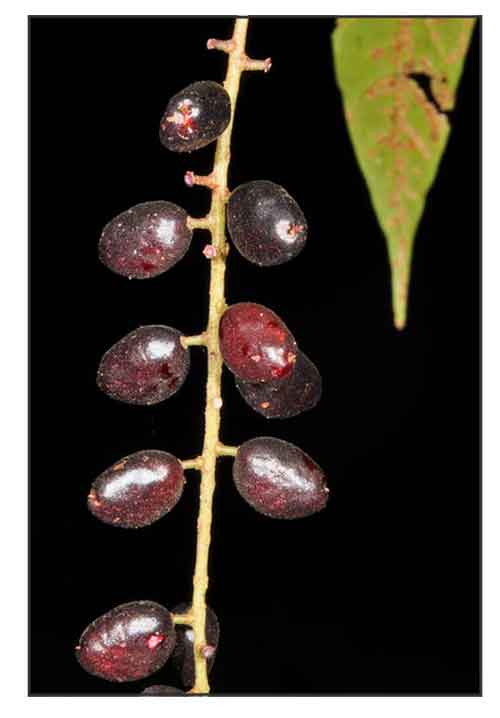
Family • Phyllanthaceae
Tiga
Antidesma tomentosum Blume
BALERAHAY
| Scientific names | Common names |
| Antidesma tomentosum Blume | Ata tamsi (Manobo) |
| Antidesma tomentosum var. genuinum Pax & K.Hoffm. | Balerahay (Manobo) |
| Accepted infraspecifics (2) | Bongay (Manobo) |
| Antidesma tomentosum var. stenocarum (Airy Shaw) Petra Hoffm. | Bungoy (Sub.) |
| Antidesma stenocarpum Airy Shaw | Gelebiray (Sub.) |
| Antidesma leptodictyum Airy Shaw | Malindang (Sub.) |
| Antidesma tomentosum var. tomentosum | Padit (Palanan-Agta) |
| Antidesma bangueyense Merr. | Tiga (Bukidnon) |
| Antidesma clementis Merr. | |
| Antidesma cumingii Müll.Arg. | |
| Antidesma foxworthyi Merr. | |
| Antidesma gibbsiae Hutch. | |
| Antidesma ilocanum Merr. | |
| Antidesma impressinerve Merr. | |
| Antidesma kingii Hoff.f. | |
| Antidesma longipes Hook.f. | |
| Antidesma megalophyllum Merr. | |
| Antidesma membranifolium Elmer | |
| Antidesma perserrula Hook.f. | |
| Antidesma persimile Kurz | |
| Antidesma rivulare Merr. | |
| Antidesma samarense Merr. | |
| Antidesma subolivaceum Elmer | |
| Antidesma tomentosum var. bangueyense (Merr.) Airy Shaw | |
| Antidesma tomentosum var. giganteum Pax & K.Hoffm. | |
| Antidesma tomentosum var. rivulare (Merr.) Pax & K.Hoffm. | |
| Antidesma urdanetense Elmer | |
| Antidesma tomentosum is an accepted species. KEW: Plants of the World Online | |
| Other vernacular names |
| BORNEO: Adadsay, Balinsaay, Kansali, Kobar, Kubor, Kobor, Rayan, Siop nanah, Sikandu, Kosa umpo, Kusiro rue, Passi haras, Sompa. |
| JAVA: Ki seuer lalaki, Tampar kidang. |
| MALAYSIA: Kayu djimang. |
May 2024
![]()
 |
| PHOTOS / ILLUSTRATIONS |
| IMAGE SOURCE: Phyllantaceae : Antidesma tomentosum / Fruiting twiG / Copyright © 2013 by P B Pelser & J F Barcelona (contact: [email protected]) [ref. DOL65386] / Non-Commercial Use / Image modified / Click on image or link to go to source page / Phytoimages.siu.edu |
| OTHER IMAGE SOURCE: Phyllantaceae : Antidesma tomentosum / Fruits / Copyright © 2012 by P B Pelser & J F Barcelona (contact: [email protected]) [ref. DOL51121] / Non-Commercial Use / Image modified / Click on image or link to go to source page / Phytoimages.siu.edu |
Additional
Sources and Suggested Readings |
• |
DOI: It is not uncommon for links on studies/sources to change. Copying and pasting the information on the search window or using the DOI (if available) will often redirect to the new link page. (Citing and Using a (DOI) Digital Object Identifier) |
| List of Understudied Philippine Medicinal Plants |
| New plant names needed The compilation now numbers over 1,300 medicinal plants. While I believe there are hundreds more that can be added to the collection, they are becoming more difficult to find. If you have a plant to suggest for inclusion, native or introduced, please email the info: scientific name (most helpful), local plant name (if known), any known folkloric medicinal use, and, if possible, a photo. Your help will be greatly appreciated. |
• |
 |



